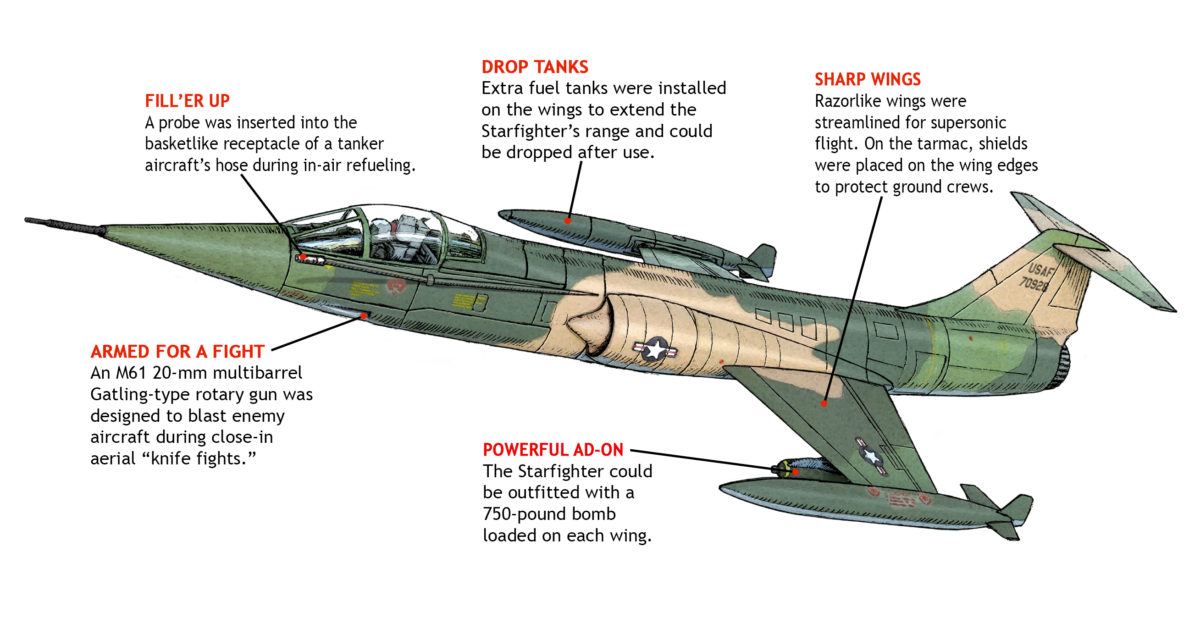In December 1951, after Lockheed Corp. aircraft designer Clarence “Kelly” Johnson returned from meetings with U.S. Air Force pilots fighting over Korea, he was committed to developing the world’s fastest and highest-flying fighter. Lockheed approved his team’s design on Oct. 31, 1952, as Model 83. The Air Force ordered two prototypes for testing on March 1, 1953.
The first XF-104 prototype flew one year later. It was noteworthy for its short, wide wing with a super-thin leading edge only 0.016 inches thick. The prototypes underwent a series of modifications to solve landing gear and stability problems that arose during testing. However, production awaited installation of the design’s intended General Electric J-79 afterburning turbojet engines. The resulting YF-104 became the basis for the F-104A that entered service in 1958, achieving several speed, climb-rate and operational flight records. Pilots called it the Zipper or Zip.
On April 19, 1965, the F-104C-equipped 476th Tactical Fighter Squadron arrived at Da Nang Air Base. The plane, a fighter-bomber variant, had a refueling probe and hard points to mount external fuel tanks, bombs or up to four AIM-9 Sidewinder infrared-guided air-to-air missiles. Its primary mission was escorting Lockheed EC-130 motherships carrying drones and the “Big Eye” early warning (radar-equipped) planes that provided surveillance support to U.S. aircraft over North Vietnam. The Starfighters also conducted strike and close-air-support missions in North and South Vietnam, as well as Operation Iron Hand missions to destroy North Vietnamese missile sites.
The F-104C’s deployment to Indochina ended on July 19, 1967, after more than 5,000 sorties. During that period, 14 F-104Cs were lost in Southeast Asia—six to groundfire, four to noncombat causes, three to Soviet SA-2 surface-to-air missiles and one to a Chinese J-6 fighter while suffering a navigation systems failure near China’s Hainan Island.
Often called “the missile with a man in it,” the F-104 was the first operational aircraft to sustain Mach 2 speed in flight. It suffered from short range, obsolete avionics, high landing speed and, until late 1967, an unreliable engine.
Nonetheless, the Starfighter served the U.S. and several of its allies well. North Vietnam’s pilots never challenged one in combat, and Italy’s air defense variant, the F-104S served through 2005, a great testimony to Johnson’s design and vision.
Crew: 1
Engine: General Electric J-79-7A turbojet with 15,500 pounds of thrust
Wingspan: 21 feet, 9 inches
Length: 54 feet, 8 inches
Max. weight: 27,853 pounds
Max. speed: Mach 2.2
Combat radius with two wing tanks: 294 nautical miles
Operating altitude: 58,000 feet
Armament: One M61 20 mm cannon; two to four AIM-9 air-to-air missiles
Bomb load: Two 750-pound bombs or rocket pods
First published in Vietnam magazine’s February 2018 issue.





